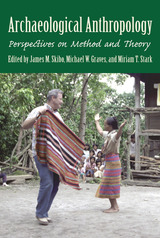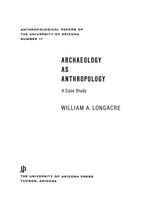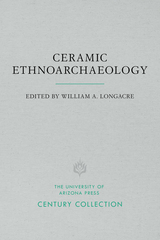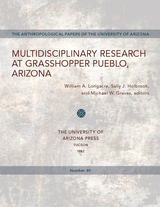4 books about Longacre, William A.

Archaeological Anthropology
Perspectives on Method and Theory
Edited by James M. Skibo, Michael W. Graves, and Miriam T. Stark
University of Arizona Press, 2014
For centuries, the goal of archaeologists was to document and describe material artifacts, and at best to make inferences about the origins and evolution of human culture and about prehistoric and historic societies. During the 1960s, however, a number of young, primarily American archaeologists, including William Longacre, rebelled against this simplistic approach. Wanting to do more than just describe, Longacre and others believed that genuine explanations could be achieved by changing the direction, scope, and methodology of the field. What resulted was the New Archaeology, which blended scientific method and anthropology. It urged those working in the field to formulate hypotheses, derive conclusions deductively and, most important, to test them. While, over time the New Archaeology has had its critics, one point remains irrefutable: archaeology will never return to what has since been called its “state of innocence.”
In this collection of twelve new chapters, four generations of Longacre protégés show how they are building upon and developing but also modifying the theoretical paradigm that remains at the core of Americanist archaeology. The contributions focus on six themes prominent in Longacre’s career: the intellectual history of the field in the late twentieth century, archaeological methodology, analogical inference, ethnoarchaeology, cultural evolution, and reconstructing ancient society.
More than a comprehensive overview of the ideas developed by one of the most influential scholars in the field, however, Archaeological Anthropology makes stimulating contributions to contemporary research. The contributors do not unequivocally endorse Longacre’s ideas; they challenge them and expand beyond them, making this volume a fitting tribute to a man whose robust research and teaching career continues to resonate.
In this collection of twelve new chapters, four generations of Longacre protégés show how they are building upon and developing but also modifying the theoretical paradigm that remains at the core of Americanist archaeology. The contributions focus on six themes prominent in Longacre’s career: the intellectual history of the field in the late twentieth century, archaeological methodology, analogical inference, ethnoarchaeology, cultural evolution, and reconstructing ancient society.
More than a comprehensive overview of the ideas developed by one of the most influential scholars in the field, however, Archaeological Anthropology makes stimulating contributions to contemporary research. The contributors do not unequivocally endorse Longacre’s ideas; they challenge them and expand beyond them, making this volume a fitting tribute to a man whose robust research and teaching career continues to resonate.
[more]

Archaeology As Anthropology
A Case Study
William A. Longacre
University of Arizona Press, 1970
This paper is important in the rapidly increasing preoccupation of American archeologists with the basic theories of their discipline. . . . An excellent example of how basic descriptive data can be used.—American Anthropologist
[more]

Ceramic Ethnoarchaeology
Edited by William A. Longacre
University of Arizona Press, 1991
Ethnoarchaeology, the study of material culture in a living society by archaeologists, facilitates the extraction of information from prehistoric materials as well. Studies of contemporary pottery-making were initiated in the southwestern United States toward the end of the nineteenth century, then abandoned as a result of changes in archaeological theory. Now a resurgence in ethnoarchaeology over the past twenty-five years offers a new set of directions for the discipline. This volume presents the results of such work with pottery, a class of materials that occurs abundantly in many archaeological sites.
Drawing on projects undertaken around the world, in the Phillipines, East Africa, Mesoamerica, India, in both traditional and complex societies, the contributors focus on identifying social and behavioral sources of ceramic variation to show how analogical reasoning is fundamental to archaeological interpretation. As the number of pottery-making societies declines, opportunities for such research must be seized. By bringing together a variety of ceramic ethnoarchaeological analyses, this volume offers the profession a much-needed touchstone on method and theory for the study of pottery-making among living peoples.
Drawing on projects undertaken around the world, in the Phillipines, East Africa, Mesoamerica, India, in both traditional and complex societies, the contributors focus on identifying social and behavioral sources of ceramic variation to show how analogical reasoning is fundamental to archaeological interpretation. As the number of pottery-making societies declines, opportunities for such research must be seized. By bringing together a variety of ceramic ethnoarchaeological analyses, this volume offers the profession a much-needed touchstone on method and theory for the study of pottery-making among living peoples.
[more]

Multidisciplinary Research at Grasshopper Pueblo, Arizona
Edited by William A. Longacre, Sally J. Holbrook, and Michael W. Graves
University of Arizona Press, 1982
“For the past twenty years the University of Arizona’s archaeological field school has been conducting research focused on Grasshopper Pueblo, a large, fourteenth-century Western Anasazi site, located below the Mogollon Rim, on the Fort Apache Reservation, in Arizona. . . . Research questions pursued at Grasshopper involve explicating the founding, growth, and abandonment of the site within the context of three broad areas of causality. These are environmental and climactic change; regional and interregional economics, especially trade; and subsistence change, including agricultural intensification. The papers in this volume . . . are presented as specialized contributions to this work.”—Journal of Anthropological Research
Contributors:
Larry D. Agenbroad
Eric J. Arnould
Walter H. Birkby
Vorsila L. Bohrer
Jeffrey S. Dean
Michael W. Graves
Sally J. Holbrook
Gerald K. Kelso
William A. Longacre
Charmion R. McKusick
J. Jefferson Reid
John W. Olsen
Stanley J. Olsen
William Reynolds
William J. Robinson
Izumi Shimada
Stephanie M. Whittlesey
David R. Wilcox
Contributors:
Larry D. Agenbroad
Eric J. Arnould
Walter H. Birkby
Vorsila L. Bohrer
Jeffrey S. Dean
Michael W. Graves
Sally J. Holbrook
Gerald K. Kelso
William A. Longacre
Charmion R. McKusick
J. Jefferson Reid
John W. Olsen
Stanley J. Olsen
William Reynolds
William J. Robinson
Izumi Shimada
Stephanie M. Whittlesey
David R. Wilcox
[more]
READERS
Browse our collection.
PUBLISHERS
See BiblioVault's publisher services.
STUDENT SERVICES
Files for college accessibility offices.
UChicago Accessibility Resources
home | accessibility | search | about | contact us
BiblioVault ® 2001 - 2024
The University of Chicago Press









